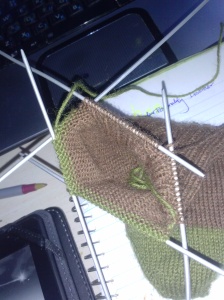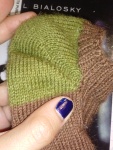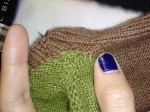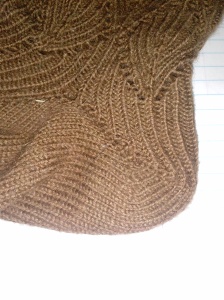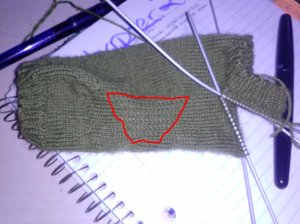So, the commercial heel I talked about before has a minor issue – there are two rows that go across the front of the foot. Perfectly fine in a heel that is in the same yarn as the rest of the foot. Slightly weird if you’re trying to do a contrast heel.
I tried omitting those rows. Eh. It’s really hard to pull a doubled stitch tight enough as is; pulling on it when the stitch below is also a doubled stitch? Eh.
In my pursuit of maximum fiddliness, I decided to try intarsia in the round.
Yes I know it’s supposed to be impossible.
It’s actually quite simple. One yarn stays in the heel part of the sock, one yarn stays in the front. They’re basically knit back and forth and intertwine at the joining point. The way I did it basically was:
Knit both yarns to the join point, one on the right side, one on the wrong side. Intertwine them. Knit them back. Intertwine them. Repeat. Remember to pull everything tight when intertwining.
And for the heel itself, for an 80 stitch sock:
Knit across the front of the sock with your Main Color (MC). Using contrast color (CC), short row in 10 stitches. (or 1/8 of the total number of stitches)
Knit back across the front of the sock with MC (yes, you’re working on the wrong side.) Knit CC to meet MC. Intertwine. Pull tight. Purl back CC to far side join point. Knit MC to far side join point. Intertwine.
Using CC, knit out to the end of the left side short rows, short row out three stitches and short row back in three stitches (or ~1/3*1/8 of total number of stitches). Knit back across the front of the sock with MC again. Knit CC to meet MC. Again. Intertwine. Pull tight. Knit CC and MC back to far side join point, working CC on wrong side. Intertwine.
Using CC, knit out to the end of the short rows, short row out ten stitches. End with a wrong-side row, intertwine, cut CC, finish sock with MC.
- Outside of contrast heel
- Inside of contrast heel – you can see the intarsia loops
